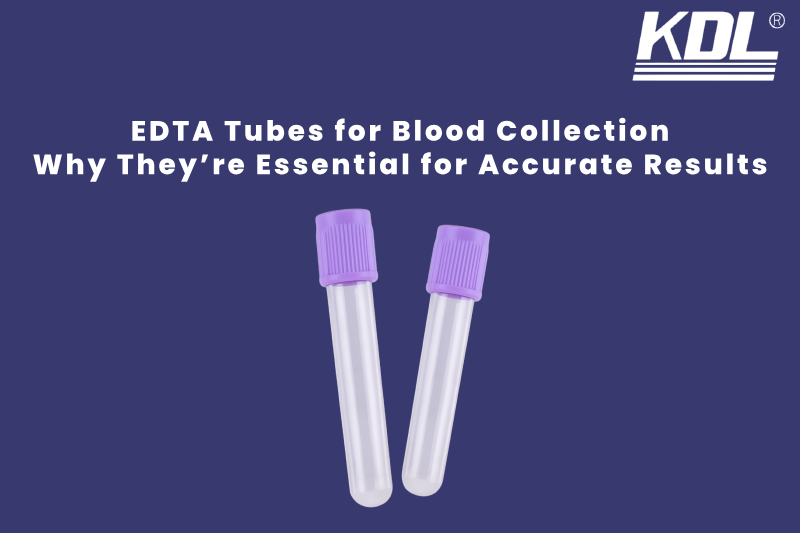
When you get blood drawn at a clinic or lab, the technician doesn’t just put the sample straight under a microscope. They need to handle it in a certain way so the test results are correct. One important part of this process is the tube they put your blood into and EDTA tubes for blood collection are one of the most important types they use..
In this guide, you’ll learn why EDTA tubes are essential for accurate results, how they work, when they’re used, and what to look for when buying them.
What Are EDTA Tubes?
EDTA tubes are special blood collection tubes that contain a chemical called EDTA (Ethylenediaminetetraacetic acid). This chemical is an anticoagulant, which means it stops blood from clotting after it’s drawn from your vein.
Lab technicians quickly identify these tubes by their purple or lavender caps, which signal what’s inside and how to handle the sample.
EDTA tubes are essential in tests where blood cells need to stay intact and in their natural shape. Without the EDTA, the blood would clot and make certain tests impossible.
How EDTA Works in Blood Collection
The main job of EDTA in a blood collection tube is to bind with calcium in the blood. Calcium is necessary for clotting to happen. When EDTA binds to calcium, it stops the clotting process.
This is important because:
- Clotted blood can ruin test results. If the sample clots, it can’t be used for certain tests.
- Cell shape stays the same. Some tests look at the size, shape, and number of blood cells, and EDTA keeps them from changing after collection.
- Preserves the sample for hours. While blood samples should be tested quickly, EDTA helps keep them stable for a short period.
When Are EDTA Tubes Used?
You’ll see EDTA tubes used for many types of blood tests, including:
- Complete Blood Count (CBC) – This is one of the most common tests. It checks red cells, white cells, and platelets.
- Hemoglobin A1C tests – Often used to monitor diabetes.
- Blood film (smear) – To check for infections, anemia, or blood disorders.
- Reticulocyte counts – To see how fast bone marrow makes new red blood cells.
Different kinds of EDTA blood collection tubes
Not every EDTA tube is the same. Different sizes, materials, and additives are available from manufacturers.
1. K2EDTA and K3EDTA Tubes
- K2EDTA: The interior of the tube features a coating of K2EDTA, which makes it the best choice for most hematological tests because it minimizes cell shrinkage.
- K3EDTA: Automated blood analyzers occasionally use it in liquid form.
2. Tubes with and without a vacuum
- Vacuum EDTA tubes are use with regular phlebotomy devices to quickly and cleanly take blood.
- Non-vacuum EDTA tubes are use to collect samples from children or for other particular requirements.
3. Tubes made of plastic vs. glass
- Plastic EDTA tubes are safer to handle, lighter, and may be thrown away.
- Although glass EDTA tubes are not as common today, some facilities still use them.
Why EDTA Tubes Are Essential for Accurate Results
Accuracy in lab testing starts the moment blood leaves the vein. Using the wrong tube or allowing blood to clot when it shouldn’t can lead to misleading results. That can mean the wrong diagnosis, delayed treatment, or the need for another blood draw — something no patient enjoys.
Here’s a closer look at why EDTA tubes make such a difference:
1. Keeps Blood Cells in Their Natural State
Blood cells are delicate. Once they leave the body, they can quickly change shape or clump together if nothing stops the clotting process. The EDTA in these tubes binds to calcium — a key part of clotting — and stops it from happening. This means red cells, white cells, and platelets stay the same size and shape they were in your bloodstream. When the lab examines the sample, they’re looking at blood that’s still in its “original” condition, which is critical for accurate results, especially in CBC testing with EDTA tubes .
2. Prevents False or Misleading Readings
If blood clots inside the tube, it can trap platelets and white blood cells, giving test results that look normal when there’s actually a problem — or making a healthy sample appear abnormal. For example, a clotted sample might suggest low platelet counts when they’re actually fine. By preventing clots from forming, EDTA tubes help ensure that what the test measures reflects the true state of a patient’s health.
3. Supports a Wide Range of Tests from One Sample
One of the biggest advantages of EDTA tubes is flexibility. You can use a single lavender top tube for multiple hematology tests, including complete blood counts, blood smears, and reticulocyte counts, without requiring multiple needle sticks. This saves time for the lab, reduces patient discomfort, and keeps costs lower. For clinics and hospitals, this versatility among different types of EDTA tubes and their uses .
4. Safe, Reliable, and Standardized Worldwide
EDTA tubes aren’t just a local preference — they’re part of a global standard in medical testing. That means a sample collected in one country can be handle and analyz in another with the same level of accuracy. Manufacturers make the tubes under strict quality controls to ensure sterility and consistency. For healthcare providers, this reliability builds trust in the results. Their test uses equipment trusted in labs around the world, which means this for patients.
Common Mistakes When Using EDTA Tubes
Even experienced healthcare workers can make small errors that affect results:
- Shaking the tube too hard – Causes hemolysis (breaking of red blood cells).
- Wrong order of draw – Risk of cross-contamination from other additives.
- Overfilling or underfilling – Changes the chemical balance in the sample.
- Using expired tubes – EDTA may not work as well, leading to clots.
Final Thoughts
EDTA tubes for collecting blood may seem simple, but they are very important for making sure medical tests are accurate. A lot of blood tests would be less accurate or perhaps impossible without them.
Healthcare providers need to know how to use EDTA tubes correctly and why they are necessary to make sure that patients receive the appropriate diagnosis and treatment.
By selecting the correct source, clinics and laboratories can guarantee themselves a constant supply of high-quality EDTA blood collection tubes that exceed safety and testing requirements.
If you’re a doctor, a lab manager, or simply interested in how blood tests operate, it’s important to know what EDTA tubes do.
 +86-791-8686-1216
+86-791-8686-1216 

